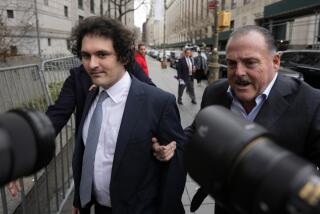Hefty Settlement Sends Former S&L; Chiefs a Message : Recovery: FDIC gains in recouping money squandered by thrifts.
- Share via
WASHINGTON — The $49.5-million settlement by Neil Bush and other former directors of a failed Colorado thrift highlights the government’s efforts to recover funds from those who regulators believe contributed to S&L; collapses.
Bush, the President’s son, and 12 other associates of Denver-based Silverado Banking, Savings & Loan of Denver agreed Wednesday to the settlement of a $200-million civil lawsuit, putting to rest allegations of gross negligence and insider dealings.
The case has drawn widespread attention because of Bush’s family connections and the size of the failure. The 1988 collapse of Silverado is expected to cost taxpayers more than $1 billion.
The settlement--while only a quarter of what was sought--is among the largest obtained by federal regulators against former directors and associates of failed financial institutions. It is part of a large-scale effort to recoup funds lost by thrifts because of alleged mismanagement, negligence or questionable insider deals.
John V. Thomas, assistant general counsel for the Federal Deposit Insurance Corp., said Thursday that the government collected $373 million last year in similar bank and thrift cases and has obtained $125 million in the first three months of this year.
Thomas, who directs the FDIC’s recovery litigation, declined to predict how much the government hopes to recoup this year, but he said the amount could be substantial if there are more big cases such as the Silverado settlement.
Most of the settlement money comes from funds set up to indemnify officers and directors against claims stemming from their actions or from liability insurance covering them and accountants and attorneys providing services to these banks and thrifts.
“The insurance companies provide the overwhelming majority of the money we collect,” Thomas said Thursday. “This is true of cases involving directors and officers, and other professionals (such as) accountants and attorneys.”
In the Silverado case, the thrift made hundreds of millions of dollars in risky real estate loans while Bush and the others served as directors. The projects failed and drove the Denver-based thrift into insolvency. In a lawsuit filed after the S&L;’s collapse, the government charged that the officials paid themselves excessive salaries and diverted millions of dollars in thrift funds for their personal use. The thrift officials denied the charges.
The settlement will give the government $23 million from a special fund the Silverado board set aside in case of lawsuits. Bush and the other defendants agreed to pay $26.5 million, and these funds are expected to come from an insurance liability policy, sources indicated.
The settlement follows a familiar pattern in bank and thrift cases filed by the government. The defendants’ personal assets are a relative pittance compared to the insurance money. And the defendants would use all the insurance money on legal fees before giving up and allowing their personal assets to be seized.
Any legal defense costs are deducted from the insurance policy, providing an incentive to settle the cases before they go to trial. The government gets more money that way, Thomas said.
The biggest settlement was achieved last year when the government collected $68 million for a case involving former officers of Eureka Savings & Loan, based in San Carlos, Calif. The defense had already spent $32 million and was amassing legal fees of $1 million a month.
In many cases, the government has moved to recoup funds against thrift attorneys and accountants as well. In the Silverado case, the FDIC is still pursuing a case against Coopers & Lybrand for its 1987 audit of the thrift.
Cases against accountants often involve failure to find fraud, or failure to tell the S&L; to set aside a sufficient reserve to cover the cost of loans gone bad. The accountants “do not have to find every fraud, but they should find every one a good audit would have discovered,” Thomas said. “They do not have to identify every problem with the loan (portfolio), but they should discover problems a good audit would reveal.”
More to Read
Inside the business of entertainment
The Wide Shot brings you news, analysis and insights on everything from streaming wars to production — and what it all means for the future.
You may occasionally receive promotional content from the Los Angeles Times.










